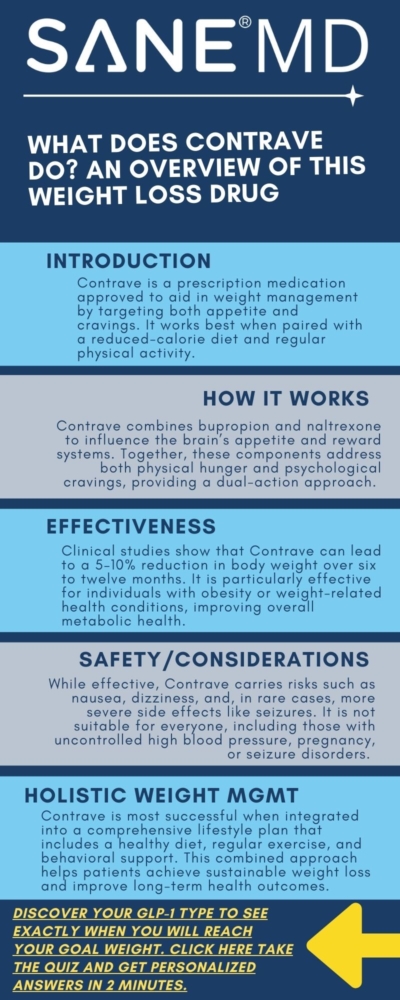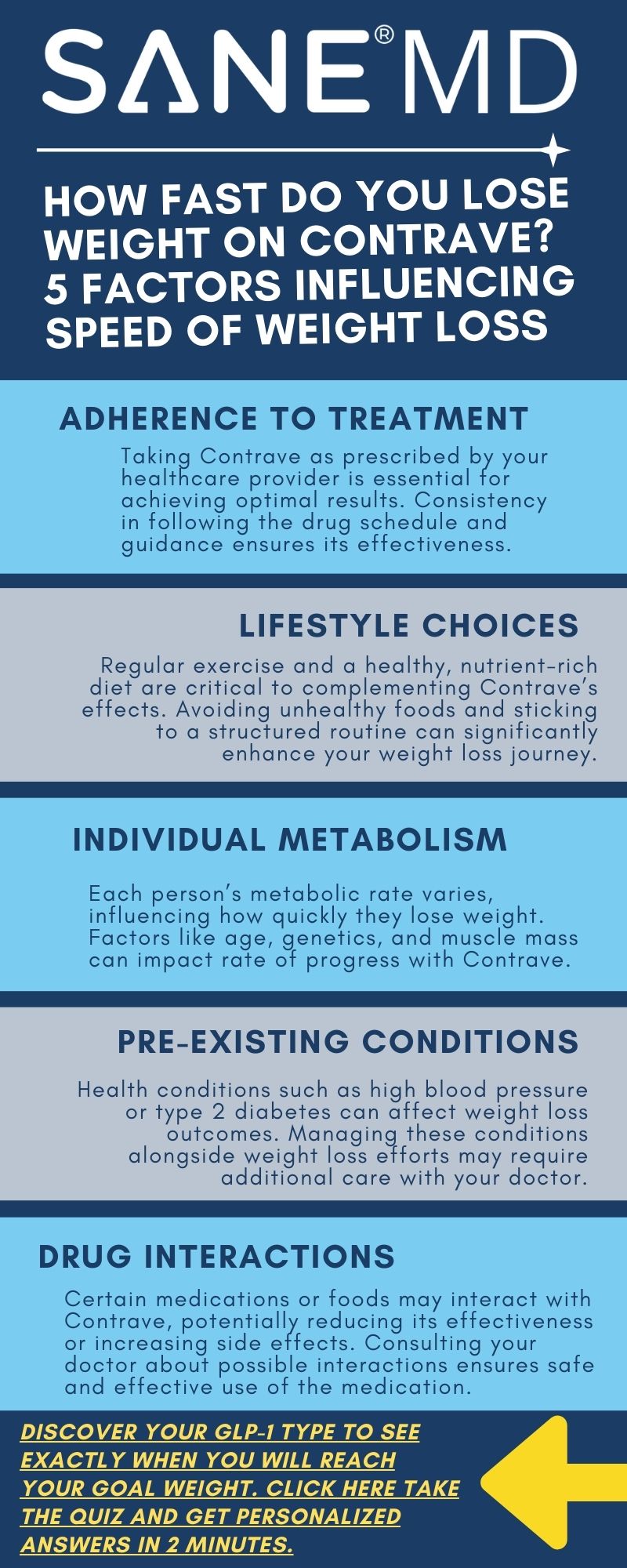What Does Contrave Do? Weight Loss and Cravings Control
Contrave is an FDA-approved prescription medication designed to aid in weight management. Combining bupropion and naltrexone, it targets both appetite and cravings to help compatible individuals achieve sustainable weight loss when paired with a reduced-calorie diet and increased physical activity.
For people struggling with weight-related medical conditions or obesity, taking Contrave under the supervision of a healthcare provider can be a critical part of a broader treatment plan.
But what does Contrave do?
This article will explore how Contrave works, its effectiveness, and important considerations for individuals and healthcare professionals. It will also address potential side effects, safety warnings, and how to integrate Contrave treatment into a holistic weight management strategy.
Key Takeaways
- Dual Mechanism of Action: Contrave combines bupropion and naltrexone to target both appetite suppression and cravings control, addressing key challenges in weight management.
- Clinical Effectiveness: When combined with diet and exercise, Contrave can help individuals lose 5-10% of their body weight, improving overall metabolic health.
- Comprehensive Weight Management: Contrave works best as part of a holistic plan, incorporating lifestyle changes, behavioral support, and regular monitoring by healthcare providers.
How Contrave Works
Contrave combines two active ingredients, bupropion hydrochloride and naltrexone hydrochloride, to target different aspects of weight management. Together, they influence the central nervous system to reduce appetite and control cravings.
Bupropion, commonly used to treat depression and assist with smoking cessation, impacts neurotransmitters to suppress appetite. Naltrexone, an opioid antagonist, is primarily used to treat opioid dependence and alcohol addiction, but in Contrave, it helps regulate reward-driven eating behaviors.
Mechanisms of Action
- Appetite Suppression: Bupropion targets dopamine and norepinephrine, which can reduce the brain’s drive to consume excess calories.
- Cravings Reduction: Naltrexone modulates the brain’s reward system, decreasing the desire for high-fat meals or other unhealthy foods.
- Dual Approach: The combination of these mechanisms helps certain patients achieve weight loss by addressing both physical and psychological triggers of overeating.
- Extended-release tablets: Contrave’s extended-release formulation ensures a steady release of the medication, maximizing its efficacy while minimizing side effects. Patients taking Contrave typically start with a lower dose, gradually increasing under the guidance of their healthcare provider.
Mechanisms of Action of Contrave
| Aspect | Details |
|---|---|
| Appetite Suppression | Bupropion reduces the brain’s drive to overeat. |
| Cravings Reduction | Naltrexone decreases reward-driven eating behaviors. |
| Dual Approach | Combines physical and psychological overeating control. |
Effectiveness of Contrave for Weight Loss
Contrave has been studied extensively in clinical trials to evaluate its effectiveness in helping patients lose weight.
The results show that, when combined with diet and exercise, Contrave can significantly improve weight loss outcomes compared to placebo.
Clinical Trial Highlights
- Weight Reduction: Studies reveal that patients taking Contrave experience an average weight loss of 5-10% of their body weight over 6-12 months.
- Body Mass Index (BMI): Contrave is especially effective for individuals with a BMI of 30 or higher or those with a BMI of 27 or higher who have weight-related medical conditions such as high blood pressure or type 2 diabetes.
- Improved Metabolic Health: Participants in trials often reported reduced waist circumference, better blood sugar control, and lowered blood pressure levels.
Role of Diet and Exercise
Contrave is most effective when used in conjunction with a reduced-calorie diet and regular physical activity.
This comprehensive approach helps compatible patients build sustainable habits to maintain their weight loss.
Safety Considerations and Potential Side Effects
Taking Contrave is not without risks. Healthcare providers must assess a patient’s health history and current medical conditions before prescribing this medication.
Common Side Effects of Contrave
- Nausea: One of the most frequently reported side effects, often subsiding as the body adjusts.
- Headache: Some patients may experience mild to moderate headaches.
- Dizziness: Particularly during the initial stages of treatment.
- Constipation or Diarrhea: Digestive issues are common but usually manageable.
- Insomnia: Bupropion’s stimulating effects can disrupt sleep patterns in some individuals.
Serious Side Effects
- Increased Risk of Seizures: Contrave is contraindicated in individuals with seizure disorders.
- Severe Allergic Reaction: Symptoms may include throat trouble, swelling, or difficulty breathing, requiring immediate medical attention.
- Risk of Suicidal Thoughts: Particularly in young adults, patients taking bupropion may experience changes in mood or behavior.
The Boxed Warning
The FDA requires a boxed warning for Contrave, emphasizing the potential for serious mental health conditions, including suicidal thoughts and behaviors.
Healthcare providers must carefully monitor patients, especially those with a history of depression or bipolar disorder.
See our comprehensive guide for a full list and explanation of Contrave side effects and safety considerations.
Who Should Avoid Contrave?
Contrave is not suitable for everyone.
Patients with certain medical conditions or on specific medications should avoid taking Contrave.
Key Contraindications
- Uncontrolled High Blood Pressure: Contrave can exacerbate this condition, posing an increased risk to cardiovascular health.
- Opioid Use or Dependence: As an opioid antagonist, Contrave can trigger opioid withdrawal symptoms.
- Pregnancy and Breastfeeding: The effects of Contrave on an unborn child or breast milk are not well studied, so it should be avoided during these periods.
- Seizure Disorders: Individuals with a history of seizures face a higher risk when taking Contrave.
Drug Interactions
It is crucial for patients to inform their healthcare provider about all the prescription drugs, over-the-counter medications, and supplements they are currently using.
Certain combinations, such as taking Contrave and Ozempic together, may lead to dangerous drug interactions or reduce the efficacy of Contrave.
Practical Tips for Taking Contrave
Patients starting Contrave treatment should follow their healthcare provider’s instructions to ensure safety and effectiveness.
Gradually increasing the dose helps to reduce side effects and allows the body to adjust.
Key Guidelines
- Avoid High-Fat Meals: Consuming high-fat meals can increase the risk of side effects, such as nausea.
- Do Not Drink Alcohol: Alcohol consumption can exacerbate the risk of seizures and other side effects.
- Monitor Health Changes: Patients should alert healthcare professionals to any new or worsening symptoms, including allergic reactions or changes in mood.
Stopping Contrave
Abruptly stopping Contrave can lead to withdrawal symptoms or a return of cravings.
Always consult a healthcare provider before discontinuing the medication.
Contrave as Part of a Holistic Weight Management Plan
Contrave is most effective when integrated into a comprehensive weight management plan.
This approach includes addressing dietary habits, increasing physical activity, and receiving ongoing support.
Building a Sustainable Plan
A sustainable weight management plan goes beyond simply taking medication. It requires a well-rounded approach that incorporates healthy lifestyle changes and continuous monitoring.
Below are the key components of an effective plan:
1. Diet and Exercise
A reduced-calorie diet paired with regular physical activity is the foundation of successful weight management. Diet plans should focus on nutrient-dense foods, such as lean proteins, legumes, fruits, and vegetables, while reducing consumption of processed foods and high-fat meals.
Exercise doesn’t have to involve rigorous workouts; even moderate activities like walking, cycling, or swimming for 30 minutes a day can significantly enhance weight loss outcomes.
Consistency in diet and exercise routines is crucial for long-term success.
2. Behavioral Support
Adopting new eating habits and a more active lifestyle can be challenging, especially for those who struggle with emotional eating or psychological triggers.
Behavioral support programs can make a substantial difference by helping patients identify and address these triggers. Support may include group therapy, one-on-one counseling with a dietitian or therapist, or access to free and confidential resources, such as volunteer crisis counselors or online support communities.
These resources provide encouragement and accountability, both of which are critical for maintaining motivation.
3. Regular Monitoring
Routine check-ins with a healthcare provider ensure that patients remain on track and that the treatment plan is effective.
During these visits, healthcare providers can evaluate progress, adjust dosages, and address any side effects or challenges.
Regular monitoring also allows for early detection of any health concerns that may arise during the weight loss journey, such as low blood sugar or high blood pressure.
4. Setting Realistic Goals
Unrealistic expectations can lead to frustration and derail progress. A healthcare provider can help patients set achievable, measurable goals, such as losing 1-2 pounds per week or improving specific health markers like blood pressure or cholesterol levels.
These small, incremental victories can build confidence and reinforce healthy behaviors.
5. Consistency and Patience
Weight management is not a quick fix; it’s a lifelong commitment to healthier habits. Patients should be prepared for periods where progress may slow or plateau.
Healthcare professionals can offer guidance on overcoming these challenges, whether through adjusting the treatment plan or providing additional support.
By integrating Contrave into a comprehensive weight management plan that emphasizes these elements, patients can achieve sustainable results while improving their overall health and well-being.
This holistic approach not only enhances the effectiveness of the medication but also equips individuals with the tools and habits needed for long-term success.
Understanding the Risks of Contrave
Most Serious Warnings
Contrave carries significant warnings that patients should be aware of before beginning treatment. One of the most serious warnings is the potential risk of suicidal thoughts, particularly in young adults. Healthcare providers are advised to monitor these patients closely for any behavioral changes.
Additionally, patients with bipolar disorder may be at an increased risk of experiencing adverse mental health effects.
Allergic Reactions
Contrave may cause mild allergic reactions such as skin rashes or itching. In rare cases, a severe allergic reaction could occur, leading to symptoms like throat trouble or difficulty breathing.
This constitutes a medical emergency, and patients should contact local emergency services immediately if such symptoms arise.
Interactions with Other Medications
Drug interactions can pose serious risks, especially when taking Contrave with other medications affecting the central nervous system or metabolism.
Patients should always provide their healthcare provider with a complete list of medications they are using to avoid potential complications.
Comparing Contrave to Other Weight Loss Treatments
Contrave is one of several prescription drugs approved by the Food and Drug Administration (FDA) for weight loss. But is Contrave the Best Weight Loss Solution for you? It certainly stands out due to its dual-action approach targeting both appetite and cravings.
However, other treatments, such as over-the-counter supplements, differ significantly in their mechanisms and effectiveness.
Prescription Drugs
Unlike over-the-counter options, prescription drugs like Contrave undergo rigorous testing for safety and efficacy.
Healthcare professionals must carefully assess a patient’s suitability for Contrave before prescribing it.
Over-the-Counter Options
Over-the-counter weight loss supplements often lack the robust clinical evidence supporting prescription medications.
While they may offer short-term benefits, they are unlikely to address the complex psychological and physiological factors influencing weight gain.
The Role of Healthcare Providers
Healthcare providers play a crucial role in the success of Contrave treatment.
From prescribing the medication to monitoring progress, their involvement ensures that patients use the medication safely and effectively.
Initial Assessment
Before prescribing Contrave, healthcare providers will evaluate the patient’s health history, including any pre-existing conditions such as high blood pressure, bipolar disorder, or seizure disorders.
This assessment helps determine whether Contrave is a safe option.
Ongoing Support
Healthcare providers offer ongoing support through regular check-ins, dose adjustments, and monitoring for potential side effects.
This partnership fosters accountability and helps patients stay on track with their weight management goals.
Frequently Asked Questions about Contrave
Many individuals considering Contrave for weight management have questions about its benefits, potential downsides, and how it compares to other treatments.
Below, we address common queries to help you make informed decisions about your weight loss journey.
What are the benefits of taking Contrave?
Contrave helps individuals lose weight by targeting both appetite and cravings, addressing key challenges in weight management. Clinical trials show significant weight loss for patients who pair Contrave with diet and exercise.
Additionally, it can improve metabolic health by reducing blood pressure and controlling blood sugar levels.
How long does it take for Contrave to work?
Many patients start noticing appetite and craving control within a few weeks of starting Contrave. Significant weight loss typically occurs over 6-12 months when combined with a comprehensive diet and exercise program.
Results can vary based on individual adherence and health conditions.
What is the downside of Contrave?
The downsides of Contrave include potential side effects such as nausea, dizziness, and insomnia. Serious risks, such as increased seizure risk or suicidal thoughts, require careful monitoring by healthcare providers.
It’s not suitable for everyone, including those with certain medical conditions.
What is better, Ozempic or Contrave?
Ozempic and Contrave serve different purposes and use different mechanisms. While Ozempic is a GLP-1 receptor agonist primarily for diabetes management, it also aids in weight loss. Contrave is specifically designed for weight management by targeting appetite and cravings.
The choice depends on individual health needs and should be guided by a healthcare provider.
How does Contrave make you lose weight?
Contrave’s combination of bupropion and naltrexone works by suppressing appetite and reducing cravings for high-fat meals. This dual approach helps individuals stick to a reduced-calorie diet, which is essential for weight loss.
It addresses both physical and psychological factors behind overeating.
What to avoid while on Contrave?
Patients should avoid high-fat meals, as these can increase the risk of nausea and other side effects. Drinking alcohol is discouraged, as it can exacerbate side effects like dizziness and increase seizure risk.
Always consult a healthcare provider before combining Contrave with other medications.
Is Contrave hard on your heart?
Contrave can raise blood pressure and heart rate, making it unsuitable for individuals with uncontrolled high blood pressure or significant cardiovascular issues.
Regular monitoring by a healthcare provider ensures that heart health is not adversely affected during treatment.
How fast do you lose weight on Contrave?
Weight loss on Contrave varies but typically averages 5-10% of body weight over 6-12 months when combined with diet and exercise.
Results depend on individual adherence to the treatment plan and lifestyle changes.
Is Contrave better than phentermine?
Contrave and Phentermine have different mechanisms of action. Phentermine is a stimulant that suppresses appetite, while Contrave targets both appetite and cravings.
For a detailed comparison of their effectiveness, side effects, and suitability, check out our guide on Contrave vs. Phentermine to help determine which option may be best for your weight loss journey.
Contrave may offer more sustainable results for long-term weight management, but the choice depends on individual needs and medical conditions.
How long does it take for Contrave to work?
Patients often experience reduced appetite and fewer cravings within the first few weeks of starting Contrave.
However, noticeable weight loss results typically occur after several months of consistent use alongside diet and exercise.
Conclusion
Taking Contrave can be a transformative step for individuals struggling with obesity or weight-related medical conditions. By addressing both the physiological and psychological aspects of overeating, Contrave offers a unique approach to weight loss. However, its use requires careful consideration of potential risks, side effects, and the importance of integrating it into a broader treatment plan.
With the guidance of healthcare professionals and a commitment to lifestyle changes, patients can achieve meaningful weight loss and improved health outcomes. As with any prescription medication, individuals should consult their healthcare provider to determine whether Contrave is the right choice for their weight management journey.
How Fast Do You Lose Weight on Contrave?
Losing weight is a journey that often requires a combination of diet, exercise, and, in some cases, medical intervention. One such intervention is Contrave, a prescription weight-loss medication designed to assist compatible patients struggling with obesity or weight-related medical conditions.
So, how fast do you lose weight on Contrave?
If you are considering Contrave or are curious about its effectiveness, this article explores how it works, how quickly you might see results, and the factors that can influence your weight loss journey.
Key Takeaways
- Effective Weight Loss Aid: Patients using Contrave, alongside diet and exercise, can lose 5% to 10% of their initial body weight within 16 to 56 weeks, with some seeing results as early as the first month.
- Lifestyle Integration Required: Contrave works best when paired with a reduced-calorie diet, regular exercise, and behavioral changes, emphasizing a holistic approach to weight management.
- Potential Risks and Suitability: Common side effects include nausea and dizziness, while more serious risks may occur. Consultation with a healthcare provider is essential to determine if Contrave is right for you.
What Is Contrave?
Contrave is not an over-the-counter medication; instead, it’s a prescription drug that combines naltrexone and bupropion, two medications that affect the brain’s reward and hunger systems.
It is specifically approved for certain adults with a body mass index (BMI) of 30 or higher, or those with a BMI of 27 or higher who also have a weight-related medical condition such as high blood pressure or type 2 diabetes.
By targeting emotional eating and reducing cravings, Contrave can help patients achieve their weight loss goals.
Comparison of Weight Loss Options
| Medication | How It Works | Ideal For | Key Considerations |
|---|---|---|---|
| Contrave | Reduces cravings and emotional eating | Adults with a BMI ≥30 or BMI ≥27 with weight-related conditions | Requires a healthy diet and exercise for best results; may cause side effects like nausea. |
| Ozempic | Regulates appetite and blood sugar | Patients with type 2 diabetes | Effective for weight loss; primarily a diabetes medication. |
| Phentermine | Suppresses appetite | Short-term use for weight management | Not suitable for long-term use; potential side effects include insomnia and increased heart rate. |
| Lifestyle Changes | Healthy eating and regular exercise | Anyone aiming for sustainable weight loss | Requires consistency and long-term commitment; no medication-related risks. |
How Does Contrave Work?
Contrave works by combining naltrexone, which is used to treat addiction, and bupropion, an antidepressant that can reduce appetite and cravings. Together, these components target specific areas of the brain involved in regulating hunger and reward.
This dual-action approach can support weight loss efforts by helping patients adhere to a reduced-calorie diet and improved exercise plan.
How Fast Do You Lose Weight on Contrave?
The speed at which patients lose weight while taking Contrave varies based on several factors, including adherence to a healthy diet and exercise regimen.
Clinical trials have shown that patients using Contrave alongside diet and exercise lose an average of 5% to 10% of their initial body weight over 16 to 56 weeks.
While individual results vary, some patients begin noticing weight loss within the first month of treatment.
The Role of Diet and Exercise
Contrave is not a standalone solution. It works best when combined with lifestyle changes, including a healthy diet and increased physical activity.
Following a structured exercise plan and eating nutrient-dense foods can significantly enhance your results.
Avoiding high-fat meals when taking Contrave is essential, as consuming a high-fat meal can increase the risk of side effects.
Success Stories: Real Results
Many patients report success when taking Contrave, achieving significant weight loss and improvements in their overall health.
These success stories often highlight the importance of combining the medication with a comprehensive treatment plan, including a balanced diet, exercise, and behavioral changes.
Factors Influencing Weight Loss with Contrave
- Adherence to Treatment Plan: Consistently taking Contrave as prescribed and following your healthcare provider’s recommendations can maximize your results.
- Lifestyle Choices: Incorporating regular exercise and avoiding unhealthy foods are key to achieving and maintaining weight loss.
- Individual Metabolism: Metabolic rates differ from person to person, which can affect how quickly you lose weight.
- Pre-existing Conditions: Conditions such as high blood pressure or type 2 diabetes can influence your weight loss journey.
- Drug Interactions: Discuss potential interactions with other medications or certain foods with your doctor before starting Contrave.
Who Should Take Contrave?
Contrave is designed for adults who struggle with obesity or are overweight with a weight-related medical condition.
Patients should not take Contrave if they are currently taking opioids, have uncontrolled high blood pressure, or are on monoamine oxidase inhibitors.
A thorough discussion with your healthcare provider can help determine if Contrave is right for you.
Potential Side Effects and Risks
As with any medication, Contrave comes with potential side effects. Common side effects include nausea, constipation, and dizziness. More serious risks, such as increased risk of suicidal thoughts, may occur in some patients.
Always discuss potential side effects with your healthcare professional and report any adverse reactions.
Contrave vs. Other Weight Loss Medications
Compared to other medications, Contrave offers a unique combination of benefits by addressing both hunger and cravings. Our Contrave vs Phentermine guide provides a detailed comparison between these two frequently prescribed weight loss pills.
However, it’s important to note that weight loss medications, including Contrave, are most effective when combined with a comprehensive weight management plan.
Lifestyle Changes for Long-term Success
While Contrave can help kickstart your weight loss journey, sustaining your results requires long-term lifestyle changes. Here are several strategies to ensure long-term success:
- Adopt a Balanced Diet: Focus on eating a healthy, nutrient-dense diet that includes lean proteins, legumes, fruits, and vegetables. Reducing calorie intake while ensuring you consume essential nutrients is key to maintaining weight loss. Avoid processed foods, sugary beverages, and high-fat meals that can hinder your progress.
- Establish an Exercise Routine: Regular physical activity is essential for long-term weight management. Aim for at least 150 minutes of moderate-intensity exercise per week, such as walking, swimming, or cycling. Incorporate strength training exercises to build muscle and boost your metabolism.
- Address Emotional Eating: Emotional eating can sabotage weight loss efforts. Identify triggers such as stress, boredom, or sadness, and develop healthier coping mechanisms like mindfulness, journaling, or seeking support from a therapist.
- Set Realistic Goals: Break your weight loss journey into achievable milestones. Celebrate small victories to stay motivated and avoid feeling overwhelmed by long-term objectives.
- Stay Consistent: Consistency is critical for lasting success. Stick to your healthy habits even after you’ve reached your goal weight. Gradual changes are more sustainable than extreme diets or workout routines.
- Monitor Your Progress: Regularly track your weight, food intake, and exercise habits. Keeping a journal or using a tracking app can help you stay accountable and identify areas for improvement.
- Build a Support System: Surround yourself with supportive friends, family, or a weight loss community. Sharing your journey with others can provide encouragement and accountability.
- Practice Mindful Eating: Pay attention to hunger and fullness cues. Eat slowly, savor your meals, and avoid distractions like watching TV while eating. Mindful eating can prevent overeating and improve your relationship with food.
- Work with a Healthcare Provider: Maintain regular check-ins with your doctor or a registered dietitian to evaluate your progress and adjust your treatment plan if necessary. They can provide guidance tailored to your needs and health conditions.
- Focus on Overall Health: Remember that weight loss is just one aspect of a healthier lifestyle. Prioritize other factors like getting enough sleep, managing stress, and staying hydrated to support your overall well-being.
By incorporating these lifestyle changes into your routine, you can enhance the effectiveness of Contrave and maintain your weight loss results for years to come.
Clinical Studies on Contrave
Clinical trials have demonstrated the effectiveness of Contrave in promoting weight loss.
In one study, patients lost an average of 5% to 10% of their body weight over one year when combined with diet and exercise. These findings underscore the importance of a holistic approach to weight management.
Tips for Taking Contrave Safely
- Follow Your Doctor’s Instructions: Take Contrave exactly as prescribed.
- Avoid High-fat Meals: High-fat meals can increase the risk of side effects.
- Monitor Side Effects: Report any unusual symptoms to your healthcare provider.
- Combine with Lifestyle Changes: Pairing Contrave with a healthy diet and exercise enhances its effectiveness.
When to Stop Taking Contrave
If you do not lose at least 5% of your initial body weight within 12 weeks, your doctor may recommend discontinuing Contrave.
Stopping the medication should always be done under the guidance of a healthcare provider.
FAQ: Common Questions About Contrave
If you’re considering or already taking Contrave as part of your weight loss journey, you might have specific questions about its effectiveness, usage, and comparisons with other medications.
Below are answers to some frequently asked questions.
How long does it take to lose weight on Contrave?
Most patients begin to notice weight loss within the first month of taking Contrave, provided they combine it with a reduced-calorie diet and regular exercise. Clinical studies show that patients can lose 5% to 10% of their initial body weight within 16 to 56 weeks.
However, individual results vary based on adherence to the prescribed treatment plan and lifestyle factors.
How to maximize weight loss on Contrave?
To maximize weight loss, follow your doctor’s instructions and take Contrave as prescribed. Pair the medication with a healthy diet, avoiding high-fat meals that may increase the risk of side effects.
Regular exercise and addressing behaviors like emotional eating can further enhance results. Staying consistent with lifestyle changes is key to achieving your weight loss goals.
Which is better, Ozempic or Contrave?
Both Ozempic and Contrave are effective weight-loss medications, but they work differently and are suited for different patients.
Ozempic is a GLP-1 receptor agonist that helps regulate blood sugar and appetite, making it ideal for patients with type 2 diabetes. Unlike Contrave and Phentermine, which are both oral medications, Ozempic is administered via injection. Contrave, on the other hand, targets emotional eating and cravings, making it a preferred choice for those struggling with long-term weight management.
While Ozempic and Contrave serve different purposes, many people also compare Contrave vs Phentermine, since both are oral prescription medications designed for weight loss. Additionally, because Contrave contains bupropion (the active ingredient in Wellbutrin), some individuals explore Contrave and Wellbutrin to understand how the medications differ in their effects on weight loss, mood, and overall health. Each has distinct mechanisms, benefits, and considerations, making it essential to choose the right option based on individual health needs and goals.
Your healthcare provider can help determine which medication is more appropriate for your specific needs and health conditions.
What is the downside of Contrave?
Contrave can cause side effects such as nausea, constipation, and dizziness, especially during the initial stages of treatment. More serious risks include increased blood pressure and, in rare cases, suicidal thoughts.
Additionally, it may not be suitable for individuals with certain medical conditions or those taking other medications, such as opioids or monoamine oxidase inhibitors.
Consulting with your healthcare provider is essential to weigh the benefits and risks.
Conclusion
Contrave can be a valuable tool for compatible individuals struggling to lose weight, particularly when combined with diet, exercise, and behavioral changes.
While results vary, clinical trials and success stories highlight its potential to help patients achieve their weight loss goals.
Always consult with your healthcare provider to determine if Contrave is right for your treatment plan, and follow their guidance for safe and effective use.
Exploring Contrave Side Effects and Safety Considerations for Weight Loss
Introduction
Contrave is a prescription medication designed to aid weight loss in a subset of adults struggling with obesity or weight-related health conditions. Contrave treatment involves careful administration and dosage adjustments to ensure efficacy and safety.
Combining two active ingredients, bupropion and naltrexone, Contrave targets brain functions linked to appetite and cravings. While it has shown promise in helping compatible individuals manage their weight, it is essential to understand potential Contrave side effects and safety considerations for weight loss before starting this medication.
This article provides an overview of how Contrave works, explores its common and serious side effects, and highlights essential safety considerations. By offering comprehensive, factual information, this guide aims to help readers make informed decisions about using Contrave under medical supervision.
Key Takeaways
- Contrave combines bupropion and naltrexone to help suppress appetite and control cravings.
- Common side effects include nausea, headache, and constipation, which are often temporary.
- Serious risks, like seizures or mental health changes, require immediate medical attention.
- Regular healthcare monitoring is crucial for safe use.
What is Contrave and How Does It Work for Weight Loss?
Contrave is a combination medication consisting of bupropion, an antidepressant, and naltrexone, a medication used to treat alcohol and opioid dependence. Together, these ingredients influence the hypothalamus, a brain region that regulates appetite and energy balance. By reducing hunger and curbing cravings, Contrave supports weight management in conjunction with diet and exercise.
Approved by the Food and Drug Administration (FDA) in 2014, Contrave is intended for adults with a body mass index (BMI) of 30 or higher or a BMI of 27 or higher with at least one weight-related health issue, such as type 2 diabetes or high blood pressure.
Contrave does not rely on stimulants, making it a beneficial option for individuals who may not tolerate stimulant-based medications.
Effectiveness and Benefits of Contrave
Contrave has been shown to support weight loss by targeting the brain’s appetite and reward centers. By helping to reduce hunger and manage cravings, it may assist individuals in adhering to a reduced-calorie diet, contributing to more consistent weight management efforts.
Clinical studies suggest that combining Contrave with lifestyle changes, including a balanced diet and regular physical activity, can lead to significantly improved weight loss outcomes compared to lifestyle changes alone.
A key benefit of Contrave is its potential to support weight loss and maintenance, which may contribute to improvements in weight-related health conditions such as hypertension, type 2 diabetes, and high cholesterol.
For instance, shedding excess weight can contribute to lowering blood pressure, enhancing blood sugar control, and decreasing the likelihood of developing type 2 diabetes. Additionally, weight loss can alleviate joint stress, improve mobility, and enhance overall quality of life.
It’s important to remember that while Contrave can be a valuable aid in weight loss, it is not a magic pill. Sustainable weight loss requires a commitment to healthy eating and regular exercise. By incorporating Contrave into a comprehensive weight management plan, certain individuals can increase their chances of achieving long-term success.
If you’re still wondering, ‘Is Contrave the best weight loss solution’, our comprehensive guide can provide deeper insights to help you decide.
Contrave Side Effects and Safety Considerations for Weight Loss
Contrave weight loss medication comes with potential side effects.
Common Side Effects
Most individuals experience some side effects when starting Contrave, particularly as their body adjusts to the medication.
These side effects are generally mild and tend to improve over time. Commonly reported issues include:
1. Trouble Sleeping
Insomnia or trouble sleeping is a common side effect associated with the use of Contrave. Many users report difficulty falling asleep or staying asleep. To manage this, consider the following tips:
- Take Contrave earlier in the day to avoid interference with your sleep cycle.
- Develop a consistent sleep schedule by going to bed and waking up at the same time each day.
- Avoid caffeine and other stimulants in the evening.
- Create a relaxing bedtime routine, such as reading a book or taking a warm bath.
- Consult your healthcare professional if trouble sleeping persists, as they may provide additional guidance or adjust your medication.
2. Nausea
This is the most frequent complaint among users, often occurring as the body acclimates to the medication. To help reduce nausea, it is advised to begin with a lower dose and gradually increase it according to your healthcare provider’s guidance.
Eating small, bland meals and avoiding heavy or greasy foods may also help alleviate symptoms.
3. Headache
Headaches are another common side effect.
Maintaining proper hydration, following a consistent sleep schedule, and managing stress levels can help reduce the likelihood of experiencing headaches.
4. Constipation
Changes in digestion, such as constipation, may occur during treatment.
Increasing dietary fiber through fruits, vegetables, and legumes, staying hydrated, and engaging in regular physical activity can help manage this symptom.
5. Dizziness
Some individuals report dizziness, particularly in the early stages of treatment. To reduce the risk of falls or accidents, avoid operating heavy machinery or driving until the dizziness subsides. Standing up slowly from a seated or lying position can also help.
Although these side effects are generally manageable, they can temporarily affect daily activities. If symptoms persist, worsen, or become difficult to manage, discussing them with a healthcare provider is crucial for continued safety and comfort.
Serious Side Effects to Watch For
While rare, certain side effects of Contrave can be serious and require immediate medical attention. Awareness of these potential risks can help users seek timely care if necessary:
1. Bipolar Disorder
Individuals with pre-existing mental health conditions, such as bipolar disorder, should be closely monitored for any mood changes or behavioral side effects when taking Contrave.
It is crucial to discuss your mental health history with your healthcare provider before starting treatment to ensure the medication is safe and suitable for you.
2. Allergic Reactions
Contrave can cause allergic reactions in some individuals. Symptoms of a serious allergic reaction include rash, swelling, and difficulty breathing.
These reactions can be life-threatening and necessitate immediate medical attention. If you experience any of these symptoms, inform your doctor right away.
3. Seizures
Bupropion, one of the active ingredients in Contrave, is associated with an increased risk of seizures. This risk is higher in individuals with a history of seizures, eating disorders, or conditions such as alcohol or drug withdrawal.
Avoiding alcohol and following prescribed dosage instructions can reduce this risk.
4. Mental Health Changes
Some users may experience mood swings, depression, anxiety, or suicidal thoughts, especially those with a history of psychiatric conditions.
If these symptoms occur, it’s critical to contact a healthcare provider immediately. Close monitoring is essential for individuals with pre-existing mental health concerns.
5. High Blood Pressure and Heart Rate
Contrave can increase blood pressure and heart rate, posing risks for individuals with uncontrolled hypertension or certain cardiovascular conditions.
Regular monitoring of vital signs during treatment is vital to ensure safety.
6. Allergic Reactions
Severe allergic reactions are rare but may present as a rash, swelling of the face or throat, or difficulty breathing.
If any of these symptoms occur, discontinue the medication and seek emergency medical care.
Contraindications include a history of seizures, uncontrolled hypertension, pregnancy, and the use of certain medications, such as monoamine oxidase inhibitors (MAOIs). Discussing your complete medical history with a healthcare provider before starting Contrave is essential to identify and mitigate these risks.
Safety Considerations Before Starting Contrave
Before starting Contrave, several factors must be carefully evaluated to ensure the medication is safe and effective for the individual:
Eligibility Criteria
Contrave is typically prescribed for certain adults with a body mass index (BMI) of 30 or higher (classified as obese) or 27 or higher (overweight) with at least one weight-related health condition, such as hypertension or type 2 diabetes.
Who Should Avoid Contrave?
Certain individuals should not take Contrave due to safety concerns. These include:
- Pregnant or breastfeeding individuals.
- Those with a history of seizures or uncontrolled high blood pressure.
- Individuals using opioid medications, as Contrave contains naltrexone, which can trigger withdrawal symptoms in such cases.
- Those taking medications that interact with Contrave, such as MAOIs or specific antidepressants.
Medical Supervision
Regular check-ins with a healthcare provider are crucial during treatment. These visits ensure that progress is monitored, side effects are addressed early, and any necessary adjustments to the treatment plan are made.
Routine monitoring of blood pressure and heart rate is especially important for individuals with pre-existing cardiovascular conditions.
Open communication with a healthcare professional and a thorough review of your medical history are essential for safely incorporating Contrave into your weight management plan.
Special Populations
Children and Adolescents
Contrave is not approved for use in children and adolescents under the age of 18. The safety and effectiveness of Contrave in this population have not been established.
If you are a parent or guardian of a child who is overweight or obese, talk with your child’s healthcare professional about other treatment options that may be available.
There are various approaches to managing weight in younger individuals, including lifestyle modifications, behavioral therapy, and, in some cases, other medications that are specifically approved for pediatric use.
Older Adults
Contrave can be used in older adults, but it’s essential to monitor their blood pressure and kidney function regularly. Older adults may be more susceptible to the side effects of Contrave, such as dizziness, headache, and nausea.
If you are an older adult taking Contrave, talk with your healthcare professional about any concerns you have regarding your treatment. Regular check-ups can help ensure that the medication is working effectively and that any potential side effects are managed promptly.
Pregnancy and Breastfeeding
Contrave is not recommended during pregnancy, as it may harm the unborn baby. If you become pregnant while taking Contrave, talk with your healthcare professional about stopping the medication.
Contrave is also not recommended during breastfeeding, as it may pass into breast milk and harm the baby. If you are breastfeeding and taking Contrave, talk with your healthcare professional about alternative treatment options.
It’s crucial to weigh the benefits and risks of continuing the medication during these periods and to explore other safe and effective weight management strategies.
It’s essential to note that Contrave is not a substitute for a healthy diet and regular exercise. To achieve and maintain weight loss, it’s crucial to make sustainable lifestyle changes, including a balanced diet and regular physical activity.
Combining Contrave with a healthy lifestyle, including a balanced diet and regular physical activity, can enhance the likelihood of achieving and maintaining meaningful weight loss.
Tips for Safe Use of Contrave
To maximize the benefits of Contrave while minimizing potential risks, it’s important to follow these safety tips:
- Follow Dosage Instructions: Always take Contrave as prescribed by your healthcare provider. Do not exceed the recommended dosage, as this increases the risk of serious side effects such as seizures. Gradual dose escalation, as advised, can also help the body adjust more comfortably.
- Avoid Alcohol: Consuming alcohol while taking Contrave can heighten the risk of seizures and exacerbate other side effects, such as dizziness or nausea. It is best to limit or eliminate alcohol intake during treatment. Always talk with your doctor about your alcohol consumption to ensure safe medication use, especially if you are a regular drinker.
- Adopt a Healthy Lifestyle: For optimal results, pair Contrave with a balanced diet and regular physical activity. While the medication can aid in weight loss for individuals, long-term success depends on maintaining healthy habits. Focus on nutrient-dense foods, portion control, and sustainable exercise routines.
- Stay Informed: Educate yourself about potential side effects and maintain regular communication with your healthcare provider. Reporting any unusual symptoms early can help prevent complications and ensure the medication is working correctly for you.
- Consult Your Doctor: Always talk with your doctor about any side effects or concerns you may have while taking Contrave. Your healthcare provider can offer personalized advice, adjust dosages if necessary, and discuss alternative treatment options to ensure the best outcomes for your health.
By adhering to these tips, individuals can reduce risks, improve the efficacy of Contrave, and achieve better overall weight management outcomes.
Frequently Asked Questions About Contrave
1. Who is eligible to take Contrave?
Contrave is prescribed for adults with a body mass index (BMI) of 30 or higher, indicating obesity, or for those with a BMI of 27 or higher who have a weight-related condition such as type 2 diabetes, high blood pressure, or high cholesterol.
Before starting Contrave, a healthcare provider will assess your medical history and current medications to ensure the drug is safe for you.
It is not recommended for individuals who are pregnant, breastfeeding or have a history of seizures. Contrave is also unsuitable for individuals using opioid medications due to its naltrexone component, which may cause withdrawal symptoms.
2. Can Contrave interact with other medications?
Yes, Contrave can interact with a variety of medications, including antidepressants, antipsychotics, opioids, and monoamine oxidase inhibitors (MAOIs). For example, combining Contrave with other drugs that lower the seizure threshold may increase the risk of seizures. Opioid-containing medications should also be avoided, as naltrexone can block their effects and cause withdrawal symptoms.
Contrave is available in extended-release tablets, which provide a slower and prolonged release of the medication. Always inform your doctor about any prescription or over-the-counter medications, vitamins, or supplements you are taking to avoid harmful interactions.
3. How long does it take to see results with Contrave?
Results with Contrave vary depending on various factors, but most individuals start seeing weight loss within the first four to eight weeks when the medication is paired with a reduced-calorie diet and increased physical activity.
Contrave helps individuals lose weight when combined with these lifestyle changes. Initial progress may include decreased appetite and fewer food cravings. Over 12 to 16 weeks, healthcare providers typically assess whether the medication is effective; a 5% weight loss during this period is a positive indicator of long-term success.
If minimal weight loss is observed, your doctor may discuss adjusting the treatment plan or exploring alternative options.
4. What should I do if I miss a dose?
If you miss a dose of Contrave, skip the missed dose and take the next one at your regularly scheduled time. Do not double up on doses to compensate, as this can increase the risk of side effects, such as seizures or nausea.
It’s important to follow the dosing schedule provided by your healthcare provider, which typically involves a gradual increase in dosage during the first few weeks.
Individuals with diabetes should monitor their blood sugar levels closely, as missing a dose of Contrave can affect blood sugar control and increase the risk of low blood sugar. If you’re unsure about how to proceed after missing a dose, contact your doctor or pharmacist for guidance.
5. Is Contrave covered by insurance?
Coverage for Contrave varies by insurance provider and plan. Many health insurance companies cover Contrave partially or fully if prescribed for medically necessary weight loss. However, some plans may require prior authorization or proof of a weight-related health condition.
While bupropion in Contrave can help with smoking cessation, Contrave is not specifically approved to help patients quit smoking. Without insurance, the cost of Contrave can be high, but discount programs and manufacturer coupons may help reduce out-of-pocket expenses.
It’s advisable to check with your insurer and explore cost-saving options with your pharmacy or the manufacturer.
Conclusion
Contrave offers a promising option for individuals seeking medical assistance with weight loss. However, understanding its potential side effects and adhering to safety precautions is vital for a positive experience.
Consult your healthcare provider to determine whether Contrave aligns with your health needs and goals. Informed decisions and medical guidance are the foundation of safe and effective weight loss treatments.




















